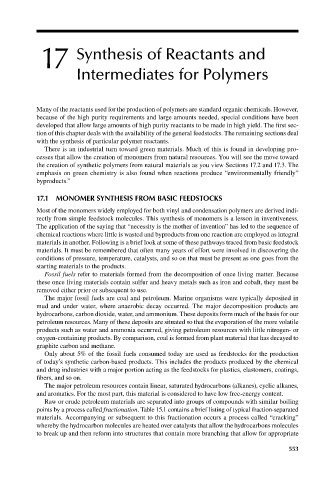Page 590 - Carrahers_Polymer_Chemistry,_Eighth_Edition
P. 590
17 Synthesis of Reactants and
Intermediates for Polymers
Many of the reactants used for the production of polymers are standard organic chemicals. However,
because of the high purity requirements and large amounts needed, special conditions have been
developed that allow large amounts of high purity reactants to be made in high yield. The fi rst sec-
tion of this chapter deals with the availability of the general feedstocks. The remaining sections deal
with the synthesis of particular polymer reactants.
There is an industrial turn toward green materials. Much of this is found in developing pro-
cesses that allow the creation of monomers from natural resources. You will see the move toward
the creation of synthetic polymers from natural materials as you view Sections 17.2 and 17.3. The
emphasis on green chemistry is also found when reactions produce “environmentally friendly”
byproducts.”
17.1 MONOMER SYNTHESIS FROM BASIC FEEDSTOCKS
Most of the monomers widely employed for both vinyl and condensation polymers are derived indi-
rectly from simple feedstock molecules. This synthesis of monomers is a lesson in inventiveness.
The application of the saying that “necessity is the mother of invention” has led to the sequence of
chemical reactions where little is wasted and byproducts from one reaction are employed as integral
materials in another. Following is a brief look at some of these pathways traced from basic feedstock
materials. It must be remembered that often many years of effort were involved in discovering the
conditions of pressure, temperature, catalysts, and so on that must be present as one goes from the
starting materials to the products.
Fossil fuels refer to materials formed from the decomposition of once living matter. Because
these once living materials contain sulfur and heavy metals such as iron and cobalt, they must be
removed either prior or subsequent to use.
The major fossil fuels are coal and petroleum. Marine organisms were typically deposited in
mud and under water, where anaerobic decay occurred. The major decomposition products are
hydrocarbons, carbon dioxide, water, and ammonium. These deposits form much of the basis for our
petroleum resources. Many of these deposits are situated so that the evaporation of the more volatile
products such as water and ammonia occurred, giving petroleum resources with little nitrogen- or
oxygen-containing products. By comparison, coal is formed from plant material that has decayed to
graphite carbon and methane.
Only about 5% of the fossil fuels consumed today are used as feedstocks for the production
of today’s synthetic carbon-based products. This includes the products produced by the chemical
and drug industries with a major portion acting as the feedstocks for plastics, elastomers, coatings,
fibers, and so on.
The major petroleum resources contain linear, saturated hydrocarbons (alkanes), cyclic alkanes,
and aromatics. For the most part, this material is considered to have low free-energy content.
Raw or crude petroleum materials are separated into groups of compounds with similar boiling
points by a process called fractionation. Table 15.1 contains a brief listing of typical fraction-separated
materials. Accompanying or subsequent to this fractionation occurs a process called “cracking”
whereby the hydrocarbon molecules are heated over catalysts that allow the hydrocarbons molecules
to break up and then reform into structures that contain more branching that allow for appropriate
553
9/14/2010 3:43:17 PM
K10478.indb 553
K10478.indb 553 9/14/2010 3:43:17 PM

